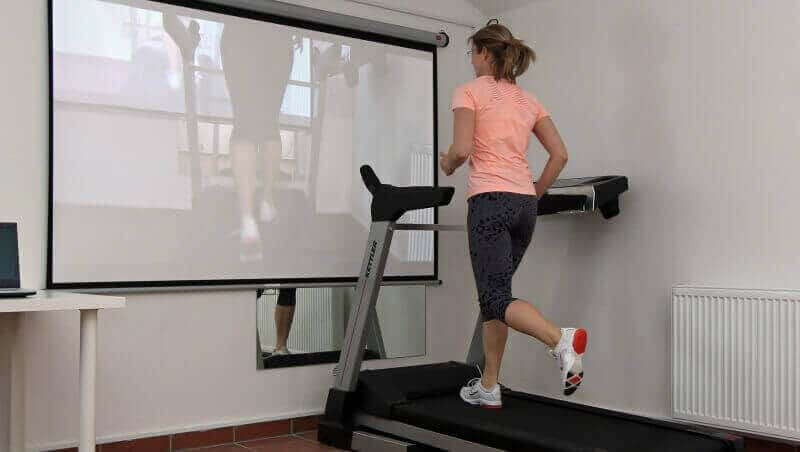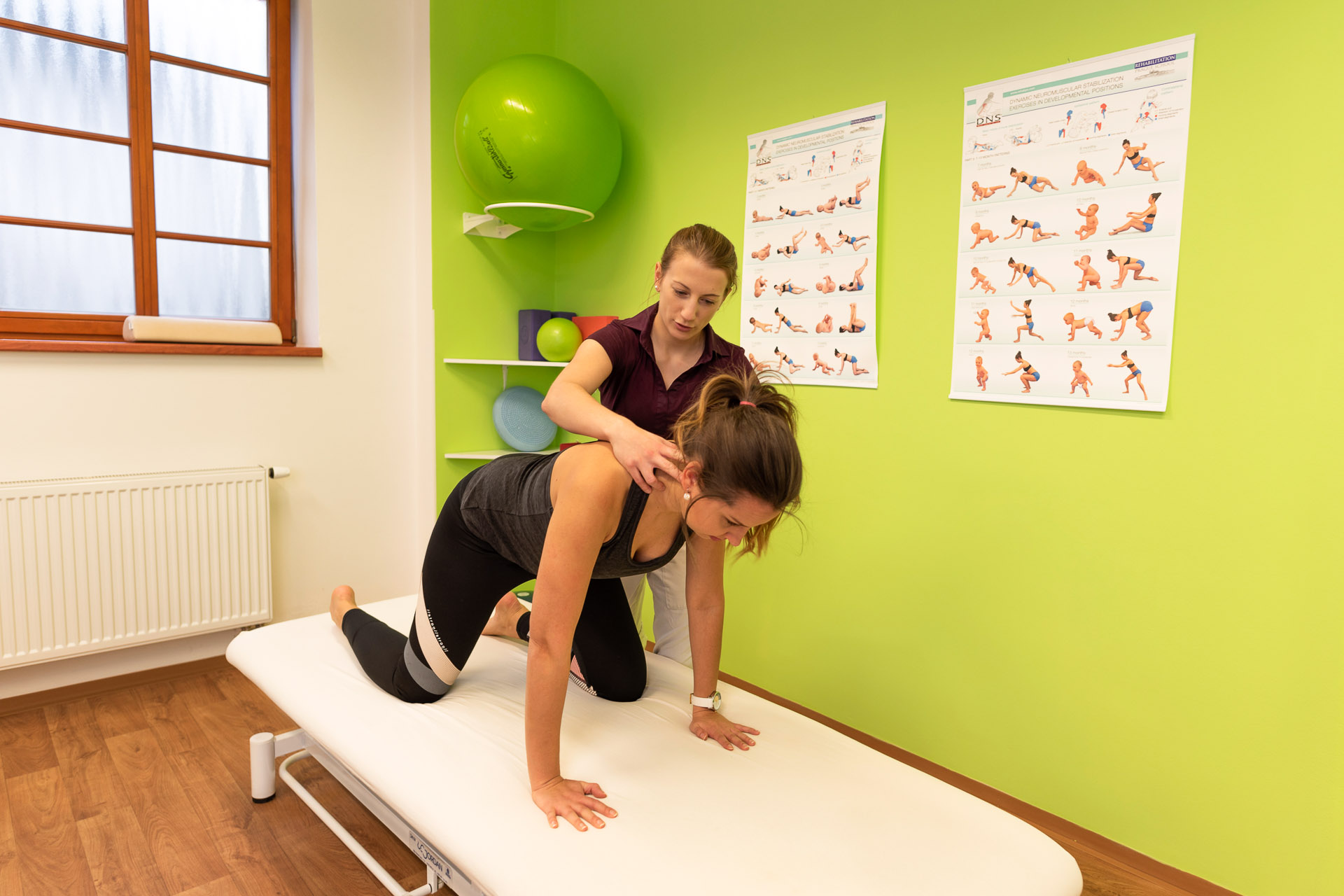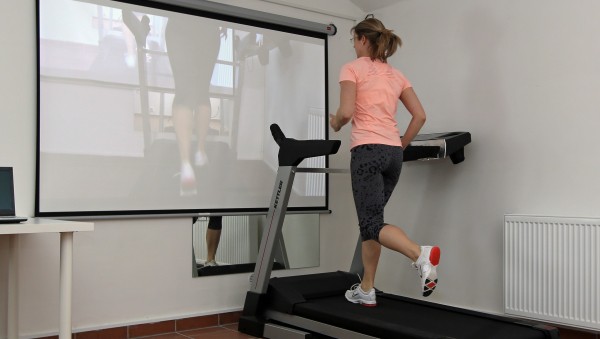Diagnostika došlapu versus diagnostika běžecké techniky
S diagnostikami došlapu či běhu se v dnešní době roztrhnul pytel. Častěji se můžeme setkat s jednodušší diagnostikou došlapu. Nabízí ji především běžecké obchody. Vyšetření probíhá tak, že se proběhnete po páse, přičemž jste filmováni kamerou, respektive pouze vaše chodidla. Natočený obrázek se poté rozfázuje a zkoumá se postavení chodidla při došlapu. Nebo se došlap vyšetřuje staticky, tedy že si stoupnete na desku, která snímá rozložení tlaků na chodidle. Pokud se kotník propadá při došlapu dovnitř, jsou vám doporučeny tzv. pronační boty, přesněji řečeno boty s kontrolou pronace. Takové boty jsou z vnitřní strany vypodloženy, takže vám podepírají podélnou klenbu. Celé to zní vcelku logicky, ale pojďme se podívat na úskalí takového vyšetření.
Postavení nohy, myšleno chodidla, při běhu závisí totiž na postavení celého těla. Došlap je tedy spíše výsledkem toho, jak je napřímená a v ose páteř a jaké je postavení kyčlí a kolen. Zjištění, že se propadá kotník dovnitř, či že se naopak noha vytáčí při došlapu na vnější stranu, je pouhá špička ledovce a prakticky nemá vypovídající hodnotu. Zpravidla je i mylné korigovat postavení nohy speciálně tvarovanou botou či vložkou.
Proč je diagnostika došlapu krátkozraká?
Pro lepší pochopení uvedu příklad. Při diagnostice došlapu vám zjistí zvýšenou pronaci tedy propad kotníku obou nohou dovnitř a doporučí pronační boty. Nezjistí se ale, že k propadu kotníku při došlapu dochází proto, že se koleno vtáčí dovnitř. A koleno se vtáčí dovnitř, protože vás nedrží dobře svaly kyčle a pánve a při došlapu se do kyčle zavěsíte. Pokud podložíme samotný kotník, svaly kyčle to pracovat nedonutí. Zvedne se sice klenba, změní se postavení holeně, ale stehno se stále bude vtáčet dovnitř. Problém se tedy jen posune o úroveň výš, tedy do kolene, které je následkem takové korekce zrotované. Srovnáte si tedy kotníky, ale rozhodíte si kolena, která se následkem nadměrné rotace přetěžují. Taková změna vám může na chvíli ulevit, třeba co se bolesti kotníku či kolene týká, zpravidla se ale po pár měsících znovu objeví. Co je ale horší, za tu dobu se díky vyztužené botě zhorší ekonomika a šetrnost vašeho běhu.
Koordinace běhu jako celku
A teď, jak může pomoci diagnostika běhu a korekce správné běžecké techniky. Při diagnostice/analýze běhu se sleduje pohyb celého těla. Parametrů, které je nutné sledovat, je mnoho. Proto každý vyšetřuje běh trochu jinak a dívá se na běh ze svého úhlu pohledu. Jinak bude vyšetřovat běh trenér a jinak fyzioterapeut. Fyzioterapeuta bude zajímat spíše zdravotní stránka věci. Bude se soustředit hlavně na asymetrie, na to, zda se určité klouby či šlachy nepřetěžují a na postavení páteře. Bude ho tedy zajímat právě třeba to, proč se propadají kotníky při běhu, nebo proč po běhu bolí záda či hlava. Trenér se bude dívat spíše na pohyb paží, dynamiku nohou, způsob došlapu a odrazu. Ideální pro kompletní analýzu běžecké techniky je spojení obou přístupů.
Vyšetření je jedna věc, ale pak jak s tím naložit, je věc druhá. Máte informace, ale měnit něco na svém těle bez zpětné vazby, je těžké. Proto je zásadním doplněním diagnostiky běhu i korekce běhu, či nácvik běžecké techniky se zpětnovazebnou kontrolou. Při běhu je totiž možné lecos měnit. Došlap je totiž možné změnit třeba změnou pohybu paže. Zapojením centra těla můžeme změnit kvalitu zpevnění a pohybu kyčlí či paží.
S během se dá prostě kouzlit. Je k tomu ale nutné znát neurofyziologické propojení práce svalů. Ač si myslíte, že změna techniky je velmi náročná, nemusí tomu tak být. Důležité je, si změnu zažít a pak ji můžete aplikovat i při běhu venku. Úpravou běhu je možné dokonce dosáhnout i okamžitého ústupu obtíží. Bolest se tedy stane pomocníkem, který vás informuje, zda zatěžujete vaše tělo správně, nebo ne.
U nás, ve fyzioterapii Be Balanced se snažíme při diagnostice běhu spojovat vyšetření z pohledu fyzioterapeuta i běžce. Naší hlavní devizou jsou naše vědomosti o práci těla, jeho zákonitostech a propojeních. Dalším zásadním přínosem naší práce je to, že váš běh nebudeme jen popisovat, ale správně běhat vás i naučíme. Běhat může skoro každý, jen je potřeba vědět jak.
Specializujeme se na sportovní fyzioterapii a především na fyzioterapii běžců. O mechanismech běžeckých zranění a o konkrétních běžeckých zranění více zde:
- bolest Achillovy šlachy, kotníku, paty, holeně
- bolest kolen při běhu
- ITB syndrom
- bolest kyčlí, třísel při běhu a chůzi
- bolest zad, krční páteře
- výhřez ploténky v bederní páteři
- špatná efektivita běhu

Mohlo by Vás také zajímat:
- Analýza a diagnostika běhu
- Výhřez ploténky a sport
- Jak se tělo vyrovnává se zraněními?
- Tenisový a golfový (oštěpařský) loket
- Hrudní páteř v cyklistice
- Sportovní zátěžový test
- Jak začít s běháním
- Střed těla, core, seznamte se! Umíme ho opravdu zapojit?
- Ultramaraton pohledem fyzioterapeuta
- Únik moči při sportu, problém, o kterém se nemluví



